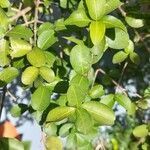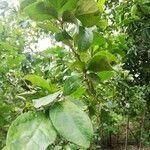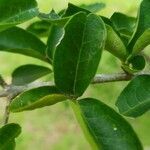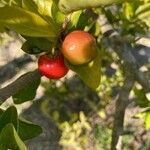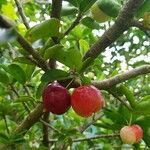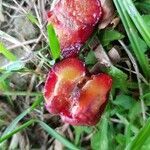Erect shrub to small tree to 6(-8) m tall, young branches, petioles and leaves green, strigillose, older branches smooth or more commonly with prominent, whitish or yellowish, round lenticels. Leaves subchartaceous to chartaceous, rarely subcoriaceous, borne laxly along the branches, internodes (2-)3-4(-5) cm long, or more commonly crowded in short shoots, internodes ca. 1.0 mm long; petioles slender, usually glabrous (1-)1.5-3.0(-4) mm long; blades variously el-liptic-obovate, lanceolate-obovate, oblong-obovate or obovate, rarely ovate or widely orbicular-obovate, obtuse, usually emarginate or rarely acute at apex, acute to cuneate or rarely somewhat obtuse at base, (1-)2-5.5(-8.5) cm long, 0.7-2.5(-5) cm wide, smooth, midvein prominent below; stipules free; reddish or green, decidous or not, strigillose when young, becoming glabrous, subulate, ca. 1 mm long. Inflorescence (1-)2-4(-6)-flowered, a sessile or sub-sessile, strigillose to densely strigillose, umbel-like panicle 1.5-2(-2.5) cm long; common peduncle short or none, 0-5(-13) mm long, flowering peduncle (3-)4-7 mm long; bracts and bracteoles 1-1.5(-2) mm long; pedicels (6-)7-10(-12) mm long, ca. 2 times the length of the flowering peduncles; buds unkeeled, subglobose, 3-5 mm diam. Flowers (1-)1.3-1.7(-2) cm diam., sepals densely strigillose in bud and fruit, glands 7-10, posterior glands 1.5-2(-3) mm long, about 1/2 the length of the sepals, anterior glands smaller, 0.5-1(-1.5) mm long or rarely all glands equal in size, posterior petal (6.5-)7.5-9(-12) mm long, lateral petals 5-9 mm long; anterior petals (4-)5.5-6.5(-8.5) mm long; androecium zygomorphic; filaments 3-4 mm long; lateral filaments (and usually the anterior filament too) obviously thicker than the others, curved inwards at anthesis, usually as long as those opposite the sepals; lateral anthers 1.2-1.5 mm long, the others 0.5-1 mm long; pollination gap short, 0-0.5(-1) mm long; gynoecium zygomorphic; styles (Fig. 9E) truncate or rarely somewhat uncinate at apex, lateral styles (2.5-)3-3.5(-4) mm long, obviously thicker and 0.5-1 mm longer than the anterior, curved at the base, usually straight and ascending for the rest, anterior style straight. Fruit subglo-bose, depressed at the poles, 3-9-lobed, 1-3 cm diam., very fleshy; pyrenes ovoid, 0.7-1.5 cm long, 5-12 mm wide, the dorsal wing well developed, to 3.5 mm wide in cultivated plants, small and almost obsolete in wild populations; intermediate wings absent.
More
A small tree up to 5 m tall. Branches are brittle and easily broken. The leaves are dark green and shiny. They are long and have small hairs. These hairs can irritate the skin. Flowers are on short stalks and are pink to white with five petals. Flowers are mostly on old growth. Fruit are round and cherry like. They have 3 lobes. They are usually bright red and with a thin skin. They are 1.7 cm across.
